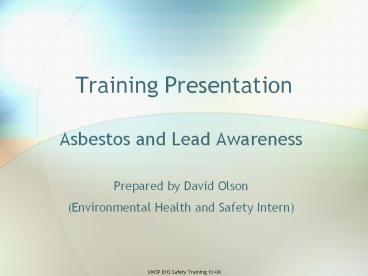Training Presentation PowerPoint PPT Presentation
1 / 20
Title: Training Presentation
1
Training Presentation
- Asbestos and Lead Awareness
- Prepared by David Olson
- (Environmental Health and Safety Intern)
2
Objectives
- Meet Training Standards described by OSHA for
Asbestos and Lead
3
Objectives (continued)
- Provide knowledge on
- Typical sources of Asbestos and lead exposure.
- Health effects related to exposure
- What to do if one suspects exposure
- Allow time for review and questions
4
Asbestos Awareness
- Asbestos is a naturally occurring mineral found
primarily in the mountain ranges of Canada, North
Central USA (Montana), and northern Eurasia.
(Magnesium silicate) - When separated from rock, asbestos becomes a
fluffy fibrous material that has many uses. - Properties
5
Asbestos Sources of ExposureFrom Safety
Orientation Handbook NOTE Bold indicates
possible uses on campus
6
Asbestos Sources of ExposureFrom Safety
Orientation Handbook NOTE Bold indicates
possible uses on campus
7
Health effects
- Routes of Exposure
- Inhalation
- Mechanism of effect
- scaring of lung tissue
- Diseases
- mesothelioma, asbestosis, or lung cancer
- Latency
- 20 to 40 years
- Why its easy to ignore the danger
- asbestos cannot be seen, smelled, or tasted
8
Health Effects
- From the National Institute of Health
- The combination of smoking and asbestos
exposure is particularly hazardous. Smokers who
are also exposed to asbestos have a greatly
increased risk of lung cancer. However, smoking
combined with asbestos exposure does not appear
to increase the risk of mesothelioma.
9
Safe Work Practices
- Do not sand, grind or pulverize tiles.
- Use wet methods and low abrasion pads slower than
300 rpm for ACM tiles/floors. - Avoid burnishing or dry buffing unless there is
enough finish to prevent contact between floor
tiles and the pad. - Do not dust, dry sweep, or vacuum deteriorated
ACM, unless you are using a HEPA vacuum. Follow
department procedure (ie use and abatement
contractor or 16 hour trained individual). - Asbestos waste is regulated not to be put in
trash. - Never use compressed air near friable ACM.
10
UWSP Asbestos
- If you suspect exposure to asbestos
- Notify your supervisor
- Helpful Resources
- WALMS http//walms.doa.state.wi.us/
- ID UWSP Password 1848
- EPA http//www.epa.gov/asbestos/Asbestos
- UWSP Asbestos Policy
- How does UWSP control exposure?
- Management in Place
- Testing to determine if ACM, if friable, if in
good condition - Asbestos Abatement contracting
- Notification to building occupants
11
Discovery of Damaged Material
- If damaged material is observed that may be
asbestos-containing, the employee should
immediately report it to his or her supervisor
and isolate the area with warning tape, pylons,
etc. Do not touch or disturb the material.
Immediately contact Facility Services and/or the
EHS Office. See the UWSP EHS Asbestos Policy for
more details.
12
Asbestos Review
- What forms of asbestos are (still) banned?
- What behavior poses a significantly greater risk
for lung cancer when exposed to asbestos? - How can one learn where ACM is used on campus?
- What are some safe work practices that you can
incorporate to minimize exposure to asbestos?
13
Lead Awareness
- Lead is a naturally occurring metallic element
found in the earths crust. Lead can be found in
many parts of the environment including
water/soil. - Lead is highly resistant to corrosion thus was
utilized widely in the past. - Properties
14
Lead Sources of ExposureFrom Safety Orientation
Handbook
- Paints (paint chips)
- Leaded Gasoline
- Drinking water
- Ammunition (lead shot)
- Cheap Jewelry
- Plumbing and solder
- Older pottery
- Lead acid batteries
- Iron and steel production
- Lead contaminated dusts
- Lead smelters (release into air)
- Foods stored in lead crystal
- Folk remedies that contain lead (for upset
stomach)
15
Regulations on Lead Exposure
- Consumer Product and Safety Commission
- banned the use of lead-based paint in 1978
- Clean Air Act
- Banned use in gasoline in 1990
- Safe Water Act
- Instituted the use of lead-free pipes, solder,
flux in plumbing operations in 1974 - Community requirements
- Air cannot exceed 0.15 micrograms/m3 (as of
10/15/2008) - Drinking water lt 15 ug per L.
- OSHA 29 CFR 1910.1025
- Permissible Exposure Limit is 50 microgram/cubic
meter for an 8-hour period.
16
Health effects
- Routes of Exposure
- Inhalation and Ingestion
- Mechanism of effect
- The exact mechanism of absorption is unknown
- Transported to other systems in body by the red
blood cells (RBC) - Lead interferes with development of hemoglobin in
RBCs - Some lead such as in dust, water, and food cannot
be seen. - Children absorb lead more easily than adults.
- Children experience more serious health effects
related to exposure to lead than adults.
17
Health Effects
- Exposure to lead can lead to
- Difficulties during pregnancy
- Other reproductive problems
- High blood pressure
- Nervous disorders
- Memory and concentration problems
- Muscle and joint pain
- Affects almost every organ in body
- Damage to kidneys
- May cause anemia at high exposures
18
Review
- How might a person be exposed to lead today?
- What makes lead more dangerous to children than
to adults? - What health effects might a person experience
from lead exposure? - How have we reduced to exposure to lead in the
general population?
19
UWSP Lead
- If you suspect exposure to Lead
- Notify your supervisor
- Get a blood test
- Helpful Resource
- EPA http//www.epa.gov/lead/pubs/leadinfo.htmfa
cts - CPSC http//www.cpsc.gov/cgi-bin/recalldb/pubpr.
asp - How does UWSP control exposure?
- Testing to determine if lead is present
- Lead Abatement contracting
- Notification to building occupants
20
- Questions?
- Thank You

